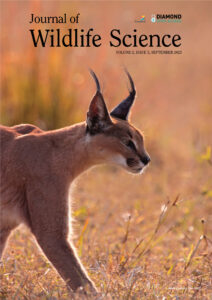TYPE: Short Communication![]()
New larval host plant records for wild silkmoths from Arunachal Pradesh in the Indian Eastern Himalaya
RECEIVED 20 June 2025
ACCEPTED 19 August 2025
ONLINE EARLY 08 September 2025
PUBLISHED 30 September 2025
Abstract
Silkmoths are both ecologically significant and economically valuable insects, with larval host plant associations playing a crucial role in shaping their development, survival, and silk yield. Arunachal Pradesh, a biodiversity hotspot in the Eastern Himalayas, harbours diverse silk moth species. However, comprehensive documentation of their host plants remains limited. Through extensive field surveys conducted in various parts of Arunachal Pradesh, we recorded 14 species of wild silkworms, and documented seven species of new host plant associations for three wild silkmoth species in addition to the previous records. The new records include Gunda ochracea Walker (Bombycidae) on Ficus rumphii Blume (Moraceae), Antheraea frithi Moore on Terminalia chebula Retz, Terminalia myriocarpa Van Heurck & Müll. Arg, Combretum pilosum Roxb. ex G.Don (Combretaceae), Lagerstroemia speciosa (L.) Martyn (Lythraceae), Castanopsis lanceifolia (Oerst.) Hickel & A.Camus (Fagaceae) and Samia canningii (Hutton, 1859) on Litsea monopetala (Roxb.) Pers. (Lauraceae). These results fill a major gap in the ecological knowledge of wild silkmoths in the Eastern Himalayas. Additionally, it supports sericultural applications of the documented larval host plants.
Keywords: Arunachal Pradesh, Bombycidae, host plant associations, Saturniidae, sericulture, wild silkmoths
Introduction
Silk is one of the most ancient and highly valuable, prized biomaterials, appreciated for its protein-based composition, tensile strength and lustre (Ki et al., 2009). While many arthropods produce silk, it is primarily the cocoons of lepidopteran larvae — especially those from Bombycidae and Saturniidae — that are utilised in sericulture. Both families belong to the superfamily Bombycoidea, noted for its capacity to produce robust silk-fibres during pupation (Zwick, 2008; Sutherland et al., 2010; Zwick et al., 2011).
The Bombycidae includes about 202 species across 27 genera, with Bombyx mori being the most domesticated and studied for mulberry silk production. Whereas Saturniidae is a highly diverse family with over 3,400 species and approximately 180 genera globally, known for wild silk varieties like tasar, muga and eri (Kitching et al., 2018). India, particularly the northeastern region, including Arunachal Pradesh, is a centre of silkmoth diversity. Arunachal Pradesh alone had a record of 27 saturniid and 10 bombycid species (Gogoi et al., 2014; Kumar et al., 2016), before the present survey.
Despite rich taxonomic data, larval host plant associations — critical for silkmoth development and silk yield — are, however, inadequately recorded in this region. Host plant selection influences not only larval survival but also cocoon quality (Vijayan, 2013; Das et al., 2020). Therefore, the introduction of new host plants could be beneficial to the sericulture sector. Furthermore, the relationship between herbivorous insects and host plants conveys the tale of coevolution and evolutionary radiation (Farrell & Mitter, 1990; Fordyce, 2010). Thus, understanding these associations can pave the way for further studies on ecological specialiszation and co-evolutionary dynamics among wild silkmoths and native host plants.
Materials and Methods
Field surveys were undertaken in different locations of Arunachal Pradesh between 2023 and 2024, covering elevations ranging from 150 to over 3,000 m above mean sea level (Figure 1). The survey locations included both planted and natural forest covers. The natural forest cover in the studied area was comprised of tropical evergreen, semi-evergreen, moist deciduous, pine, or subalpine forests.
Host plants were identified based on three key observations:
- Presence of larval excreta under host trees,
- Evidence of partial leaf consumption,
- Direct visual confirmation of larvae feeding in the wild.
- Search for cocoons, followed by a search for larvae in the same host plant
Only those host plant records with active larval feeding were considered valid. Some of the areas were visited multiple times to monitor the cocoon formation of the larvae. Some larvae were also raised in both outdoor and indoor conditions to validate the identification of the moths that developed from the larvae.
Plant voucher specimens were collected and pressed to prepare a herbarium. Plants were identified based on local floras (Kanjilal et al., 1934-1940; Hajra et al., 1996; Giri et al., 2008), and the present status of nomenclature was verified from www.plantsoftheworldonline.org (POWO, 2025). Moth identification was carried out when adult moths developed from the corresponding larva and cocoon (Peigler & Naumann 2003, Gogoi et al., 2014, Sondhi & Kunte 2014; Sondhi et al., 2025).
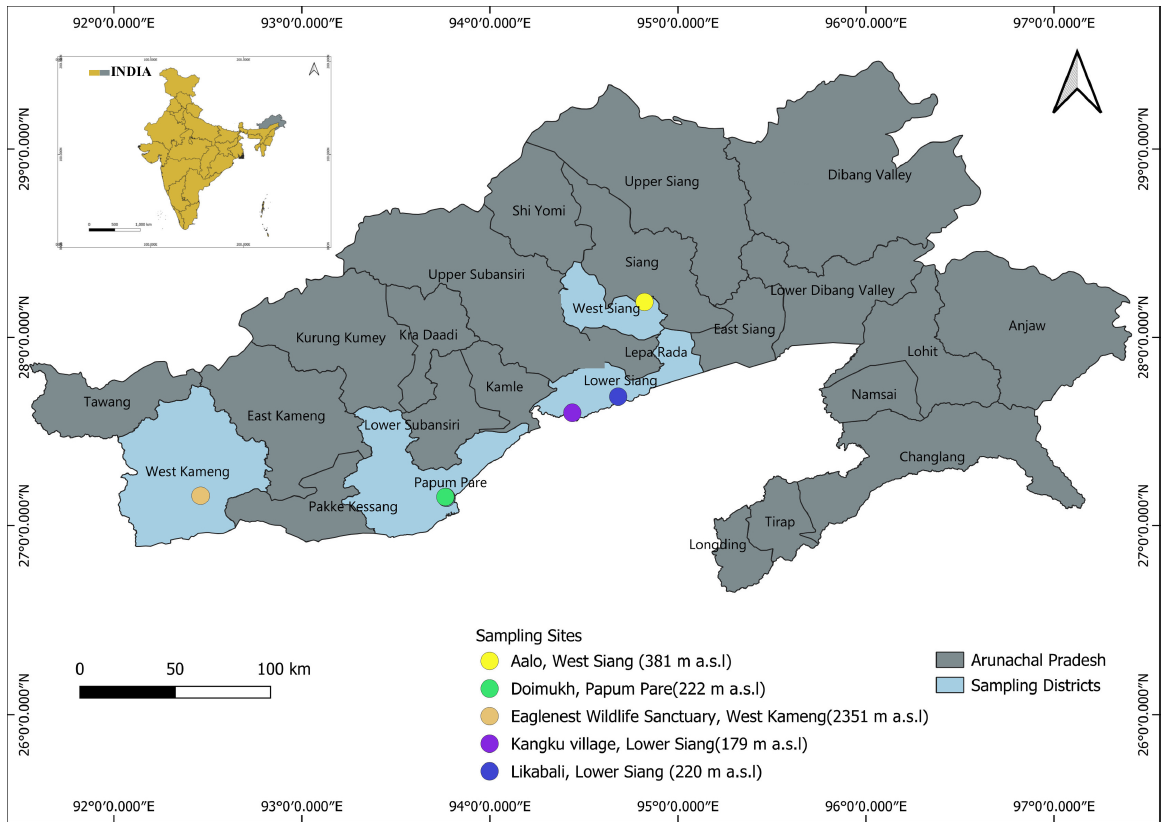
Fig. 1: A map of Arunachal Pradesh, India showing the locations where the silkworms and host plants are recorded.
Results and Discussion
During the survey, the following 14 species of wild silkmoths were recorded:
(A) Saturniidae: Tasar silkworm Antheraea frithi Moore, 1859 and Antheraea mylitta (Drury, 1773); wild race of muga silkworm Antheraea assamensis Helfer, 1837, wild eri silkworm Samia canningii (Hutton, 1859), Emperor moth Rinaca cidosa (Moore, 1865) (=Saturnia cidosa), Rinaca thibeta (Westwood, 1854) (=Saturnia thibeta), moon moths Actias selene (Hübner, 1807), Actias maenas Doubleday, 1847, Actias parasinensis Brechlin, 2009, atlas moth Attacus atlas (Linnaeus,1758) and Archaeoattacus edwardsii (White 1859), plain golden emperor moth Loepa katinka (Westwood, 1848), Cricula moth Cricula trifenestrata (Helfer, 1837)
(B) Bombycidae: Gunda ochracea Walker, 1862
Out of these, Rinaca cidosa was recorded from West Siang district and Eaglenest Wildlife Sanctuary (West Kameng district), Rinaca thibeta from West Siang district, Cricula trifenestrata and Antheraea mylitta from Lower Siang district
and all others from Papum Pare district. All larval stages, cocoons and moths were recorded for Antheraea frithi and the wild race of Antheraea assamensis. Only the fifth instar larva, cocoon and adult stages were recorded for the wild race of Samia canningii and the Rinaca cidosa. Only moth stages were recorded for the rest. Therefore, in this investigation, host plants were not assigned to these silkworms.
We report new host plant for the species as follow (Figure 2):
(A) Gunda ochracea on Ficus rumphii Blume (Rosales: Moraceae)
(B) Antheraea frithi on Terminalia chebula Retz., Terminalia myriocarpa Van Heurck & Müll. Arg, Combretum pilosum Roxb. ex G. Don (Myrtales: Combretaceae), Lagerstroemia speciosa (L.) Martyn (Myrtales: Lythraceae), and Castanopsis lanceifolia (Oerst.) Hickel & A.Camus (Fagales: Fagaceae)
(C) Samia canningii on Litsea monopetala (Roxb.) Pers. (Laurales: Lauraceae)
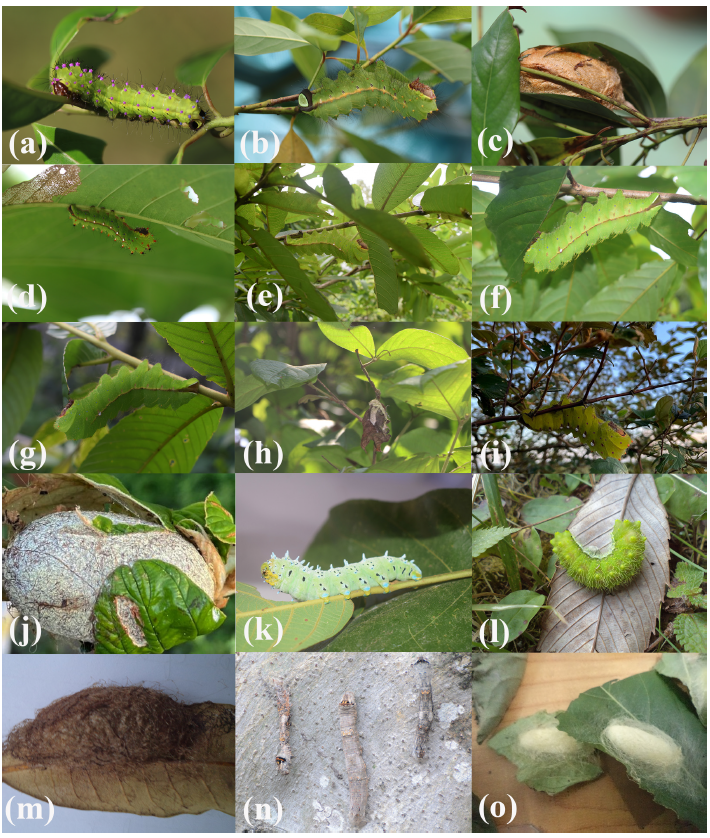
Fig. 2: (a-c) Wild race of (a) third and (b) fifth instar larva of muga silkworm, Antheraea assamensis and (c) its cocoon on Som tree, Machilus gamblei; (d-h) Larva of tasar silkworm Antheraea frithi on (d) Indian crape myrtle, Lagerstroemia speciosa, (e) Arjun tree, Terminalia arjuna, (f) Myrobalan tree, Terminalia chebula, (g) Hollock tree, Terminalia myriocarpa, (h) its cocoon on Combretum pilosum; (i, j) Tasar silkworm, Antheraea mylitta and its cocoon on Ber tree, Zizyphus mauritiana; (k) Wild eri silkworm, Samia canningii on Soalu plant, Litsea monopetala; (l, m) Larva of Rinaca moth and its cocoon; (n) Larvae of wild bombycid moth, Gunda ochracea on banyan fig tree Ficus rumphii; (o) Cocoon of Gunda ochracea.
We also observed previously recorded and known host plants (Figure 2):
(A) Wild race of Antheraea assamensis on Litsea monopetala (Roxb.) Pers. and Machilus gamblei King ex Hook.f. (=Machilus bombycina King ex Hook.f.) (Laurales: Lauraceae)
(B) Antheraea frithi on Terminalia arjuna (Roxb. ex DC.) Wight & Arn., (Combretaceae)
(C) Antheraea mylitta on Ziziphus mauritiana Lam. (Rosales: Rhamnaceae)
Further, we documented the cocoon properties of selected wild silkworm species raised on particular host plants (Table 1).
Table 1. Cocoon morphometric parameters of selected wild silkworms reared on various host plants.
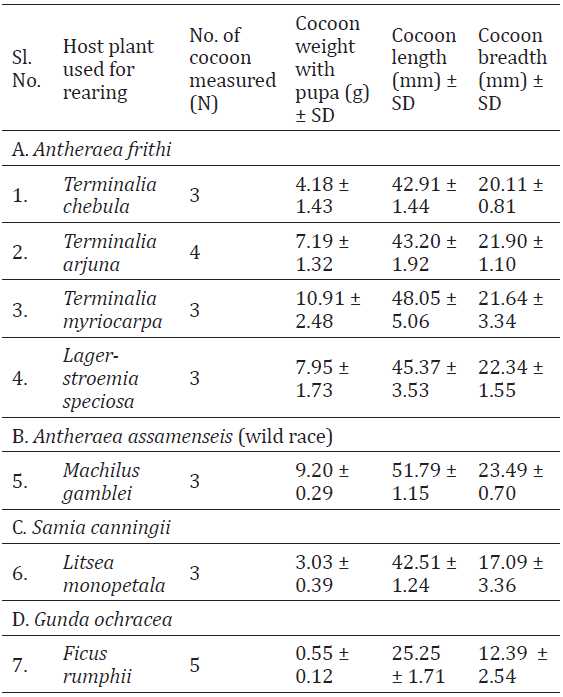
Prior reports showed that Antheraea frithi primarily feeds on species of Terminalia and members of Dipterocarpaceae and Fagaceae (Chutia et al., 2016; Singh et al., 2022). The inclusion of Lagerstroemia speciosa is a novel observation in this study. Similarly, Litsea monopetala, known as a host of semi-domesticated Antheraea assamensis, was here reported as a natural host for Samia canningii, expanding its ecological associations. As per a previous study, Samia canningii can be reared on Ricinus communis L. (Malpighiales: Euphorbiaceae) and Heteropanax fragrans (Roxb.) Seem. (Apiales: Araliaceae) — host plants it shares with the domesticated Samia cynthia (Taba & Gogoi, 2019). The current record from Lauraceae introduces a new host family for this species. The present study also shows that the larvae of Samia canningii that feed on Litsea monopetala are larger in diameter (length: ca. 58.60 mm, breadth: ca. 17.75 mm) and cocoons are larger in length and breadth (length 42.51, breadth 17.09 mm) compared to those reared on Ricinus communis and Heteropanax fragrans (length 62–65 mm, width 9–10 mm; Cocoon length 27–33 mm, breadth 12–14 mm) (Taba & Gogoi 2019). Therefore, it may be hypothesised that Litsea monopetala could be a better host plants for the purpose of the sericulture industry compared to other plants known for hosting Samia canningii. Phylogenetic proximity exists among Rosales, Fagales, Malpighiales and Myrtales, which are associated with Bombyx mori, Gunda ochracea, Antheraea frithi, Antheraea mylitta and Samia cynthia. In contrast, Laurales (host to Antheraea assamensis and Samia canningii) and Apiales (host to Samia cynthia) are more distantly related (Figure. 3) (Li et al., 2021). This divergence in host plant phylogeny may reflect adaptations of silkworms driven by domestication and ecological specialisation. These patterns suggest that Antheraea assamensis and Samia canningii may share evolutionary host plant lineages adapted to Lauraceae, diverging from other Saturniids and Bombycids whose host plants (in the family such as Lythraceae, Combretaceae, Moraceae, Fabaceae, Euphorbiaceae) are more closely related phylogenetically (Li et al., 2021).
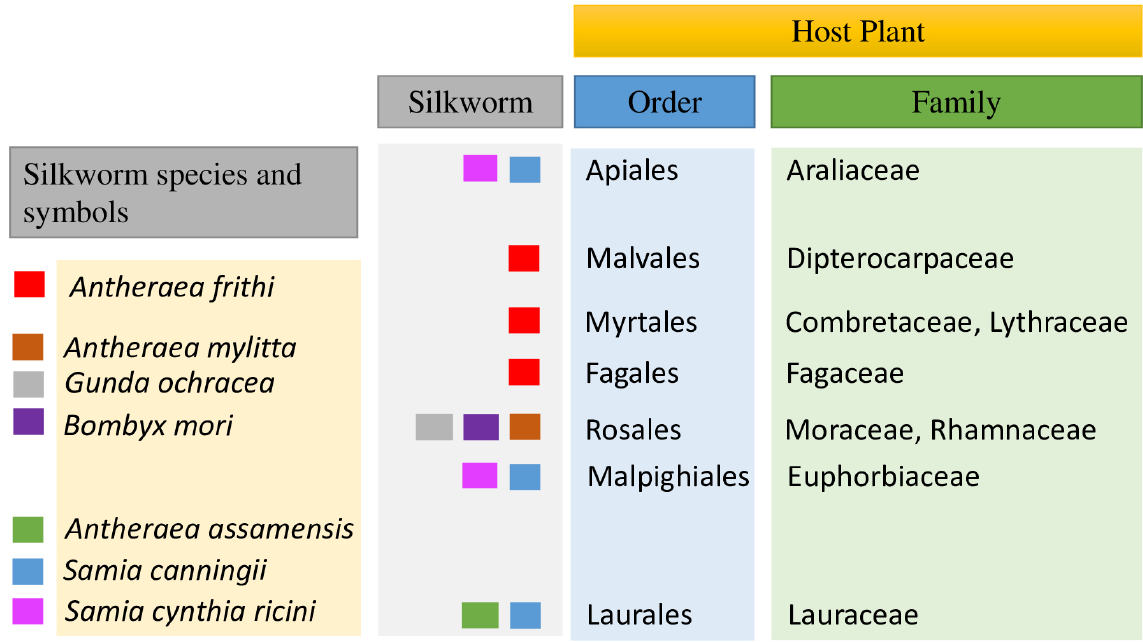
Fig. 3: Hypothetical grouping of the silkworms based on larval host plant phylogeny (Li et al., 2021).
Conclusion
This study expands our knowledge of silkmoth – host plant interactions, revealing new larval host associations for key wild silkmoth species. These findings have broad implications for evolutionary biology, conservation ecology and the development of sustainable sericultural practices in the Indian East Himalayan regions. Protecting both the moths and their host plants is essential for conserving the intricate ecological web and supporting rural livelihoods dependent on wild silk.
Acknowledgement
Authors are thankful to the Department of Zoology, Rajiv Gandhi University, Arunachal Pradesh for necessary facilities and the Office of the Principal chief Conservator of Forest and Wildlife for necessary permission to visit Eaglenest Wildlife Sanctuary, Arunachal Pradesh, India.
CONFLICT OF INTEREST
There is no actual or potential conflict of interest.
DATA AVAILABILITY
Data are available with the corresponding author on request.
AUTHORS’ CONTRIBUTION
HG, TD, SS- Survey and manuscript writing. APD-Identification of plants and
manuscript writing.
Edited By
Himendra Bharti
Biodiversity monitoring and assessment, Punjabi University, Patiala.
*CORRESPONDENCE
Hiren Gogoi
✉hirengogoi2007@yahoo.co.in
CITATION
Gogoi, H., Singh, S., Dobiam, T. & Das, A. P. (2025). New larval host plant records for wild silkmoths from Arunachal Pradesh in the Indian Eastern Himalaya. Journal of Wildlife Science, 2(3), 91-95. https://doi.org/10.63033/JWLS.ZZIG9864
FUNDING
This work partially benefited from fieldwork conducted under the project DST/CCP/NMSHE/HICAB/232/2024 (G), funded by the Climate, Energy and Sustainable Technology (CEST) Division, DST, Government of India.
COPYRIGHT
© 2025 Gogoi, Singh, Dobiam & Das. This is an open-access article, immediately and freely available to read, download, and share. The information contained in this article is distributed under the terms of the Creative Commons Attribution License (CC BY 4.0), allowing for unrestricted use, distribution, and reproduction in any medium, provided the original work is properly cited in accordance with accepted academic practice. Copyright is retained by the author(s).
PUBLISHED BY
Wildlife Institute of India, Dehradun, 248 001 INDIA
PUBLISHER'S NOTE
The Publisher, Journal of Wildlife Science or Editors cannot be held responsible for any errors or consequences arising from the use of the information contained in this article. All claims expressed in this article are solely those of the author(s) and do not necessarily represent those of their affiliated organisations or those of the publisher, the editors and the reviewers. Any product that may be evaluated or used in this article or claim made by its manufacturer is not guaranteed or endorsed by the publisher.
Chutia, B. C., Nath, C., Goswami, L. M., Goswami, B., Gogoi, L. & Neog, K. (2016). Life history of Antheraea frithi Moore, (Lepidoptera: Saturniidae) on Terminalia arjuna (Roxb.) W&A Syn. in North Eastern Region of India. Proceedings of the National Academy of Sciences, India Section B: Biological Sciences, 86(1), 83–88. https://doi.org/10.1007/S40011-014-0411-Y
Das, S. K., Sahu, B. K. & Singh, D. (2020). Host plant diversity of non-mulberry silkworms: A review. Journal of Pharmacognosy Phytochemistry, 9(3), 109–113.
Farrell, B. & Mitter, C. (1990). Phylogenesis of insect/plant interactions: Have Phyllobrotica leaf beetles (Chrysomelidae) and the Lamiales diversified in parallel?, Evolution, 44(6), 13891403. https://doi.org/10.2307/2409325
Fordyce, J. A. (2010). Host shifts and evolutionary radiations of butterflies. Proceedings of the Royal Society B, 277(1701), 3735–3743. https://doi.org/10.1098/rspb.2010.0211
Giri, G. S., Pramanik, A. & Chowdhery, H. J. (2008). Materials for the flora of Arunachal Pradesh (Vol. II). Botanical Survey of India.
Gogoi, H., Borah, G., Habung, T. & Wangsa, K. (2014). A field survey of the silk moths (Lepidoptera: Saturniidae) in West Siang district, Arunachal Pradesh and threats to their population. Journal of Bioresources, 1(1), 16–24.
Hajra, P. K., Verma, D. M. & Giri, G. S. (1996). Materials for the flora of Arunachal Pradesh (Vol. I). Botanical Survey of India.
Kanjilal, U. C., Das, A., Kanjilal, P. C., Das, A., Purakaystha, C. & De, R. N. (1934–1940). Flora of Assam (Vols. I–IV). Government of Assam.
Ki, C. S., Park, Y. H. & Jin, H. J. (2009). Silk protein as a fascinating biomedical polymer: Structural fundamentals and applications. Macromolecular Research, 17, 935–942. https://doi.org/10.1007/BF03218639
Kitching, I. J., Rougerie, R., Zwick, A., Hamilton, C. A, St. Laurent, R. A., Naumann, S., Ballesteros, M. L. & Kawahara, A. Y. (2018). A global checklist of the Bombycoidea (Insecta: Lepidoptera). Biodiversity Data Journal, 6, e22236. https://doi.org/10.3897/BDJ.6.e22236
Kumar, R., Chutia, P., Ahmed, M., Rajkhowa, G. & Singh, N. I. (2016). Checklist of wild silk moths of North East India (Lepidoptera: Saturniidae, Bombycidae). Munis Entomology & Zoology, 11(2), 508–514.
Li, H. T., Luo, Y., Gan, L., Ma, P. F., Gao, L. M., Yang, J. B., Cai, J. B., Gitzendanner, M. A., Fritsch, W. P. et al., (2021). Plastid phylogenomic insights into relationships of all flowering plant families. BMC Biology, 19, 232. https://doi.org/10.1186/s12915-021-01166-2
Peigler, R. S. & Naumann, S. (2003). A revision of the silkmoth genus Samia. University of the Incarnate Word. Faculty Books 1. https://athenaeum.uiw.edu/faculty_books/1
Plants of the World Online (POWO) (2025). Plants of the World Online. Facilitated by the Royal Botanic Gardens, Kew. https://powo.science.kew.org/. (Accessed on 7 June 2025)
Singh, L. S., Devi, S. S., Debaraj, Y., Kumari, K. M. V. (2022). Rearing performance of oak tasar silkworm, Antheraea frithi Moore, 1859 on different host plants during spring and autumn season in Manipur, India. Plant Archives, 22 (Special Issue VSOG), pp. 61–63. https://doi.org/10.51470/plantarchives.2022.v22.specialissue.013
Sondhi, S. & Kunte, K. (2014). Butterflies and Moths of Pakke Tiger Reserve. Titli Trust, Dehradun & Indian Foundation for Butterflies, Bengaluru. pp.163-201.
Sondhi, S., Sondhi, Y., Singh, R. P., Roy, P. & Kunte, K. (eds.) 2025. Moths of India, v. 3.91. Indian Foundation for Butterflies Trust. https://www.mothsofindia.org. (Accessed on 7 June 2025).
Sutherland, T. D., Young, J. H., Weisman, S., Hayashi, C. Y., & Merritt, D. J. (2010). Insect silk: one name, many materials. Annual Review of Entomology, 55, 171-188. https://doi.org/10.1146/annurev-ento-112408-085401
Taba, M. & Gogoi, H. (2019). Report on wild eri silkworm Samia canningii (Hutton, 1859) (Lepidoptera: Saturniidae) from Arunachal Pradesh, India. National Academy Science Letters, 42, 147–150. https://doi.org/10.1007/s40009-018-0678-2.
Vijayan, K. (2013). Improvement of host plants of muga silkworm (Antheraea assamensis Helfer, 1837) for higher productivity and better adaptation – A review. Plant Knowledge Journal, 2, 83–88.
Zwick, A. (2008). Molecular phylogeny of Anthelidae and other bombycoid taxa (Lepidoptera: Bombycoidea). Systematic Entomology, 33, 190–209. https://doi.org/10.1111/j.13653113.2007.00410.x
Zwick, A., Regier, J. C., Mitter, C., & Cummings, M. P. (2011). Increased gene sampling yields robust support for higher‐level clades within Bombycoidea (Lepidoptera). Systematic Entomology, 36(1), 31-43. https://doi.org/10.1111/j.1365-3113.2010.00543.x
Edited By
Himendra Bharti
Biodiversity monitoring and assessment, Punjabi University, Patiala.
*CORRESPONDENCE
Hiren Gogoi
✉hirengogoi2007@yahoo.co.in
CITATION
Gogoi, H., Singh, S., Dobiam, T. & Das, A. P. (2025). New larval host plant records for wild silkmoths from Arunachal Pradesh in the Indian Eastern Himalaya. Journal of Wildlife Science, 2(3), 91-95. https://doi.org/10.63033/JWLS.ZZIG9864
FUNDING
This work partially benefited from fieldwork conducted under the project DST/CCP/NMSHE/HICAB/232/2024 (G), funded by the Climate, Energy and Sustainable Technology (CEST) Division, DST, Government of India.
COPYRIGHT
© 2025 Gogoi, Singh, Dobiam & Das. This is an open-access article, immediately and freely available to read, download, and share. The information contained in this article is distributed under the terms of the Creative Commons Attribution License (CC BY 4.0), allowing for unrestricted use, distribution, and reproduction in any medium, provided the original work is properly cited in accordance with accepted academic practice. Copyright is retained by the author(s).
PUBLISHED BY
Wildlife Institute of India, Dehradun, 248 001 INDIA
PUBLISHER'S NOTE
The Publisher, Journal of Wildlife Science or Editors cannot be held responsible for any errors or consequences arising from the use of the information contained in this article. All claims expressed in this article are solely those of the author(s) and do not necessarily represent those of their affiliated organisations or those of the publisher, the editors and the reviewers. Any product that may be evaluated or used in this article or claim made by its manufacturer is not guaranteed or endorsed by the publisher.
Chutia, B. C., Nath, C., Goswami, L. M., Goswami, B., Gogoi, L. & Neog, K. (2016). Life history of Antheraea frithi Moore, (Lepidoptera: Saturniidae) on Terminalia arjuna (Roxb.) W&A Syn. in North Eastern Region of India. Proceedings of the National Academy of Sciences, India Section B: Biological Sciences, 86(1), 83–88. https://doi.org/10.1007/S40011-014-0411-Y
Das, S. K., Sahu, B. K. & Singh, D. (2020). Host plant diversity of non-mulberry silkworms: A review. Journal of Pharmacognosy Phytochemistry, 9(3), 109–113.
Farrell, B. & Mitter, C. (1990). Phylogenesis of insect/plant interactions: Have Phyllobrotica leaf beetles (Chrysomelidae) and the Lamiales diversified in parallel?, Evolution, 44(6), 13891403. https://doi.org/10.2307/2409325
Fordyce, J. A. (2010). Host shifts and evolutionary radiations of butterflies. Proceedings of the Royal Society B, 277(1701), 3735–3743. https://doi.org/10.1098/rspb.2010.0211
Giri, G. S., Pramanik, A. & Chowdhery, H. J. (2008). Materials for the flora of Arunachal Pradesh (Vol. II). Botanical Survey of India.
Gogoi, H., Borah, G., Habung, T. & Wangsa, K. (2014). A field survey of the silk moths (Lepidoptera: Saturniidae) in West Siang district, Arunachal Pradesh and threats to their population. Journal of Bioresources, 1(1), 16–24.
Hajra, P. K., Verma, D. M. & Giri, G. S. (1996). Materials for the flora of Arunachal Pradesh (Vol. I). Botanical Survey of India.
Kanjilal, U. C., Das, A., Kanjilal, P. C., Das, A., Purakaystha, C. & De, R. N. (1934–1940). Flora of Assam (Vols. I–IV). Government of Assam.
Ki, C. S., Park, Y. H. & Jin, H. J. (2009). Silk protein as a fascinating biomedical polymer: Structural fundamentals and applications. Macromolecular Research, 17, 935–942. https://doi.org/10.1007/BF03218639
Kitching, I. J., Rougerie, R., Zwick, A., Hamilton, C. A, St. Laurent, R. A., Naumann, S., Ballesteros, M. L. & Kawahara, A. Y. (2018). A global checklist of the Bombycoidea (Insecta: Lepidoptera). Biodiversity Data Journal, 6, e22236. https://doi.org/10.3897/BDJ.6.e22236
Kumar, R., Chutia, P., Ahmed, M., Rajkhowa, G. & Singh, N. I. (2016). Checklist of wild silk moths of North East India (Lepidoptera: Saturniidae, Bombycidae). Munis Entomology & Zoology, 11(2), 508–514.
Li, H. T., Luo, Y., Gan, L., Ma, P. F., Gao, L. M., Yang, J. B., Cai, J. B., Gitzendanner, M. A., Fritsch, W. P. et al., (2021). Plastid phylogenomic insights into relationships of all flowering plant families. BMC Biology, 19, 232. https://doi.org/10.1186/s12915-021-01166-2
Peigler, R. S. & Naumann, S. (2003). A revision of the silkmoth genus Samia. University of the Incarnate Word. Faculty Books 1. https://athenaeum.uiw.edu/faculty_books/1
Plants of the World Online (POWO) (2025). Plants of the World Online. Facilitated by the Royal Botanic Gardens, Kew. https://powo.science.kew.org/. (Accessed on 7 June 2025)
Singh, L. S., Devi, S. S., Debaraj, Y., Kumari, K. M. V. (2022). Rearing performance of oak tasar silkworm, Antheraea frithi Moore, 1859 on different host plants during spring and autumn season in Manipur, India. Plant Archives, 22 (Special Issue VSOG), pp. 61–63. https://doi.org/10.51470/plantarchives.2022.v22.specialissue.013
Sondhi, S. & Kunte, K. (2014). Butterflies and Moths of Pakke Tiger Reserve. Titli Trust, Dehradun & Indian Foundation for Butterflies, Bengaluru. pp.163-201.
Sondhi, S., Sondhi, Y., Singh, R. P., Roy, P. & Kunte, K. (eds.) 2025. Moths of India, v. 3.91. Indian Foundation for Butterflies Trust. https://www.mothsofindia.org. (Accessed on 7 June 2025).
Sutherland, T. D., Young, J. H., Weisman, S., Hayashi, C. Y., & Merritt, D. J. (2010). Insect silk: one name, many materials. Annual Review of Entomology, 55, 171-188. https://doi.org/10.1146/annurev-ento-112408-085401
Taba, M. & Gogoi, H. (2019). Report on wild eri silkworm Samia canningii (Hutton, 1859) (Lepidoptera: Saturniidae) from Arunachal Pradesh, India. National Academy Science Letters, 42, 147–150. https://doi.org/10.1007/s40009-018-0678-2.
Vijayan, K. (2013). Improvement of host plants of muga silkworm (Antheraea assamensis Helfer, 1837) for higher productivity and better adaptation – A review. Plant Knowledge Journal, 2, 83–88.
Zwick, A. (2008). Molecular phylogeny of Anthelidae and other bombycoid taxa (Lepidoptera: Bombycoidea). Systematic Entomology, 33, 190–209. https://doi.org/10.1111/j.13653113.2007.00410.x
Zwick, A., Regier, J. C., Mitter, C., & Cummings, M. P. (2011). Increased gene sampling yields robust support for higher‐level clades within Bombycoidea (Lepidoptera). Systematic Entomology, 36(1), 31-43. https://doi.org/10.1111/j.1365-3113.2010.00543.x




